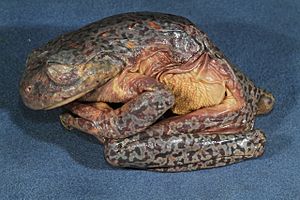Grant's big-eyed tree frog facts for kids
Quick facts for kids Grant's big-eyed tree frog |
|
|---|---|
 |
|
| Conservation status | |
| Scientific classification | |
| Synonyms | |
|
The Grant's big-eyed tree frog (Nyctimystes granti) is a fascinating type of tree frog that lives in Papua New Guinea. Scientists first discovered this large frog near the Utakwa River and Fly River areas. These places are about 1,000 meters (or about 3,280 feet) above sea level, which means they live in mountains or high hills!
This special frog is quite big for a tree frog, growing up to about 10.0 centimeters (almost 4 inches) long. It has unique black marks on its back, which might help it blend in with its surroundings. Like some other frogs, it has small teeth called vomerine teeth in its upper jaw. These teeth help it hold onto its food.
Contents
Where Grant's Big-Eyed Tree Frog Lives
Grant's big-eyed tree frogs are found only in the beautiful, lush rainforests of Papua New Guinea. This island nation is known for its amazing wildlife and diverse ecosystems. These frogs prefer to live in areas with lots of trees and moisture, which is perfect for a tree frog! They are often found near rivers and streams, where they can find food and lay their eggs.
What Do These Frogs Eat?
Like most frogs, Grant's big-eyed tree frogs are carnivores, meaning they eat other animals. They mostly munch on small invertebrates, like insects. Imagine them sitting quietly, waiting for a tasty beetle or spider to pass by, then using their long, sticky tongue to catch it! Their diet helps control insect populations in their rainforest home.
Life Cycle of a Tree Frog
The life cycle of the Grant's big-eyed tree frog is similar to many other frogs. It starts with eggs, which are usually laid in or near water. When the eggs hatch, tiny tadpoles emerge. These tadpoles live in the water, breathing with gills and eating algae or small bits of plants.
As they grow, tadpoles slowly change. They develop legs, their tails get shorter, and their gills turn into lungs, allowing them to breathe air. Eventually, they transform into young frogs, ready to leave the water and explore the trees. This amazing change from a water-dwelling tadpole to a land-dwelling frog is called metamorphosis.
Conservation Status
The Grant's big-eyed tree frog is currently listed as "Data Deficient" (DD) by the International Union for Conservation of Nature (IUCN). This means scientists don't have enough information about how many of these frogs exist or if their numbers are going up or down. More research is needed to understand their population and ensure they are protected for the future. Protecting their rainforest home is very important for these unique creatures.
See also
 In Spanish: Nyctimystes granti para niños
In Spanish: Nyctimystes granti para niños


